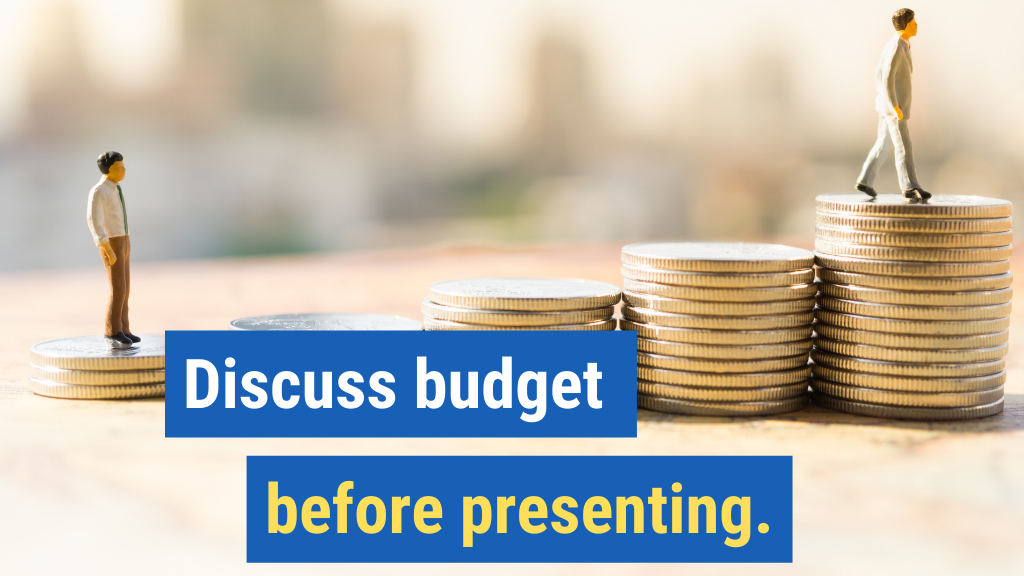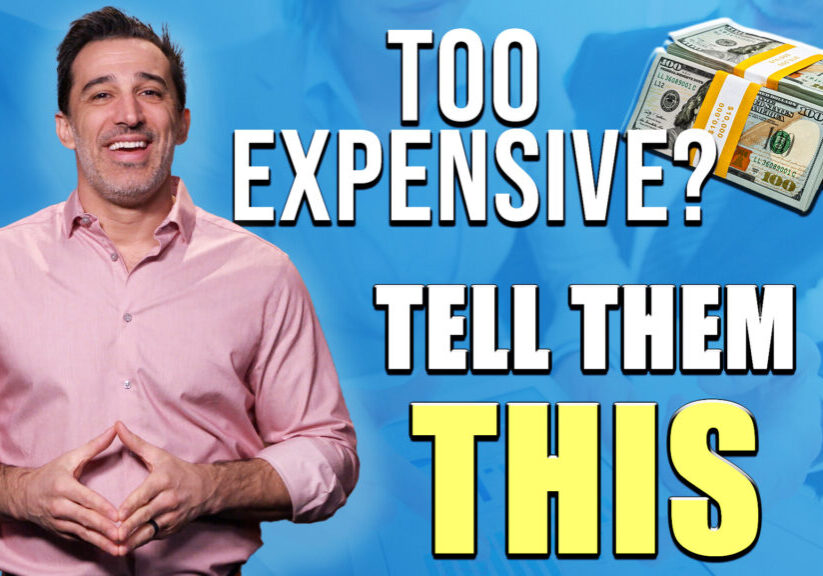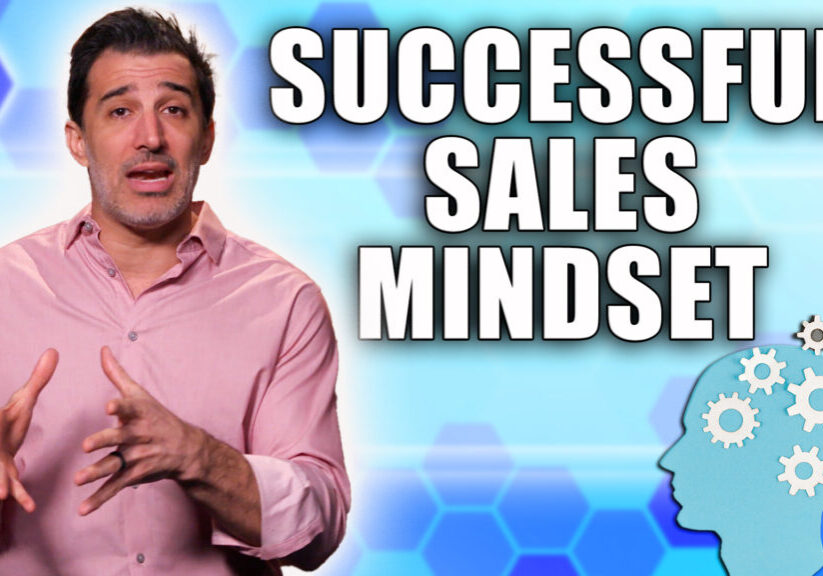Have you ever been in a selling situation that seems to be going really well—until the end of the meeting when the prospect says something like, “I can’t afford it”?
You’re not alone if you sometimes find yourself blindsided by this type of objection.
You might think things are right on track, only to have them suddenly get derailed when the prospect unexpectedly pushes back on price.
Now, the question is, what do you say when you hear that objection?
And just as important, what do you do before that situation arises in order to avoid that objection at all costs?
In this video, I’m going to show you how to deal with prospects that say, “I can’t afford it.” Check it out:

They Say, “I Can’t Afford It…” Tip #1: Assess who you’re selling to right now.
 This might sound obvious, but if you’re hearing the “I can’t afford it” objection a lot, you might simply be selling to the wrong people. I once had a mentor who always used to say, “The person who needs your solution the most is likely the person who can’t afford it.” If you’re dealing with prospects who have no money, you’re going to hear “I can’t afford it” all the time.
This might sound obvious, but if you’re hearing the “I can’t afford it” objection a lot, you might simply be selling to the wrong people. I once had a mentor who always used to say, “The person who needs your solution the most is likely the person who can’t afford it.” If you’re dealing with prospects who have no money, you’re going to hear “I can’t afford it” all the time.
And if you’re selling to the wrong people, there’s not a lot that you can do in today’s insane marketplace to make it better. There are organizations out there that don’t have money. There are people that don’t have money. You only want to be selling to those who are likely to at least be able to afford your solution in the first place.
Tip #2: Discuss their critical challenges.
 When someone who has money says “I can’t afford it,” what they’re really saying is, “I don’t see enough value in what you’re offering for me to reach into my wallet and give you money.” That’s why your first step should always be to focus on the severity of their key challenges. Get them talking about the challenges that you can ultimately help them solve. The more you get them to discuss their critical challenges, the more they’re going to see value in your offering.
When someone who has money says “I can’t afford it,” what they’re really saying is, “I don’t see enough value in what you’re offering for me to reach into my wallet and give you money.” That’s why your first step should always be to focus on the severity of their key challenges. Get them talking about the challenges that you can ultimately help them solve. The more you get them to discuss their critical challenges, the more they’re going to see value in your offering.
By digging deep into their core challenges, you’re going to effectively shine a spotlight on the hurt that they’re feeling. If you do a good job with this, it will cause them to say, “Wow, I really need to do something about this.” That’s why it’s so important to discuss their critical challenges up front.
They Say, “I Can’t Afford It…” Tip #3: Understand the value of solving those challenges.
 Getting the prospect to understand the value of solving their critical challenges is the key piece that gets them from point A to point B. It’s up to you to build the bridge to get them there. It’s your job to help the prospect determine and articulate, “What’s the actual value of moving from point A (where I am right now) to point B (a place where my challenge is finally solved)?”
Getting the prospect to understand the value of solving their critical challenges is the key piece that gets them from point A to point B. It’s up to you to build the bridge to get them there. It’s your job to help the prospect determine and articulate, “What’s the actual value of moving from point A (where I am right now) to point B (a place where my challenge is finally solved)?”
Let’s say you’re dealing with a prospect in the marketing space who’s simply not getting enough leads. They say, “I really need more leads to my business.” And so you talk all about that and really dig into the pain it’s causing them. And then you say, “Help me understand—what is this challenge costing you right now?” In response, the prospect will say something like, “Well, we’re losing tons of business at the moment because we don’t have enough leads. It’s costing us millions of dollars.”
Once the prospect understands—and articulates—that the cost of the problem is millions of dollars, your solution (which is probably only hundreds of thousands of dollars, at most) will seem totally reasonable. But it’s crucial that you get the prospect to paint that picture for you, so that they are articulating themselves the value your solution will bring.
Tip #4: Get commitment to solve the challenges.

This is really key because not all challenges are equal. If you run a business yourself, you probably have a lot of challenges in your business. And so, you know that not every challenge is created equally. You need to constantly do triage. And so your prospects are doing triage themselves, whether they’re consumers, or whether they’re business owners, or whether they work in a large company, they’re constantly doing triage and they’re deciding which problems are most important.
So it’s important that you ask questions to really understand their commitment to solving the challenges that you’re discussing. Remember this isn’t about their commitment to working with you, it’s about their commitment to actually solving the challenges. When you get that commitment, that buy-in, now you know they’re much less likely to push back on price.
“I Can’t Afford It…” Tip #5: Discuss budget before presenting.

This is one of the key distinctions in my selling system from a lot of other folks out there. You want to have a money conversation upfront before you share your solution. So you want to have that budget conversation before you actually get into what the solution looks like, what’s the price, all of that. You want to just get a sense of what budget would they be willing to put towards solving these challenges. Ensuring that you have that money conversation upfront is almost always going to avoid at the end, the situation where they say, “I simply can’t afford it.” Because you will have dealt with that upfront.
Now there are going to be prospects who simply won’t have the budget in order to work with you. But wouldn’t you rather know that before you present, at the beginning of an interaction, as opposed to at the end. You want to know before you’ve gone through, you’ve put together a proposal, you’ve done all this stuff. You’ve had multiple meetings and at the end, they’re like, “You know what, I just really can’t afford this.” You want to avoid it by discussing budget before presenting.
Tip #6: Only present to their challenges.

Salespeople tend to get really excited to present their solution, and this is a common mistake a see all the time. It’s great to be passionate about what you sell, but this enthusiasm often spills over into the presentation phase and leads to the salesperson over-sharing all the features and benefits they have to offer. And more often than not, there are benefits and features that you offer that your prospects simply aren’t looking for…and this is a landmine.
If you start presenting benefits or features that the prospect isn’t actually looking for, you’re creating a situation where they’ll start to see less value in what you offer. It’s distracting from solving their core challenges—which is all they care about. Make sure you only present the components of your offering that are directly relevant to the challenges you’ve discussed with the prospect.
Never throw the entire kitchen sink at prospects; stay focused and on track. Otherwise they’ll start to think, “Oh, okay. You know what? This is really more than I need. I don’t need all that so maybe this isn’t the right fit for what I’m actually looking for.” And that’s when you’re likely to get pushed back on price.
They Say, “I Can’t Afford It…” Tip #7: Hold their feet to the fire.

Let’s say you do everything right, but you still end up in a situation where they say, “I can’t afford it.” It happens. So while it’s imperative to do everything in your power to avoid hearing this objection in the first place, I’m going to give you some advice for how to handle “I can’t afford it” if your prospect ends up saying it anyway.
This is where you hold their feet to the fire. Don’t act like a doormat; be tough. Say something like, “I appreciate your saying that. But you mentioned at our last meeting that you challenges are costing you a couple million dollars and that you had a budget somewhere between $100,000–$200,000. What I’ve presented to you is within that budget. So help me understand what I might have missed here.”
Put it back on the prospect to explain what’s changed since your last conversation, or why they feel the way they do about the price.
It’s important to remember that if a prospect with a good budget is still saying “I can’t afford it,” it’s just a proxy for “I’m not seeing enough value.” So hold their feet to the fire and don’t back down here. Resist the temptation to try to sell them more by talking about how great your offering is. That’s crap. Just be willing to recognize that they’ve already discussed their challenges, what they’re costing them, and their budget, and hold them accountable to what they told you before. That’s how to deal with prospects when they say, “I can’t afford it.”

Enjoyed this article? Please share away!

Get instant access to our free sales training:
Why Prospects Push Back on Price, Give 'Think-It-Overs,' and Ghost in Sales Until They Meet a Sales Superstar Who Is Following These 7 Simple Keys

About the Author Marc Wayshak
Marc is is the best-selling author of three books on sales and leadership, including the highly acclaimed titles Game Plan Selling, The High-Velocity Sales Organization and his forthcoming book, Sales Conversations, Mastered.
Marc is a contributor to Inc, HubSpot, Fast Company, Entrepreneur Magazine, and Huffington Post Business. He also hosts a popular YouTube channel on sales strategy with over 103,000 subscribers.
Marc helps thousands of people his data-driven, science-based approach to selling that utilizes all the best tools available to sales organizations today.



![How-to Sell to Power [C-Suite Sales Must-Knows!] How to Sell to Power [C-Suite Sales Must-Knows!]](https://salesinsightslab.com/wp-content/uploads/bb-plugin/cache/How-to-Sell-to-Power-C-Suite-Sales-Must-Knows-1024x576-landscape-7a52c541b28a7b772ad9e1010d8240be-.jpg)


![The Absolute Best Way to Start a Sales Conversation [WITH ANY PROSPECT] The Absolute Best Way to Start a Sales Conversation [WITH ANY PROSPECT]](https://salesinsightslab.com/wp-content/uploads/bb-plugin/cache/The-Absolute-Best-Way-to-Start-a-Sales-Conversation-WITH-ANY-PROSPECT-1024x576-landscape-be9d9379ab94d9f71b5bfeed42246a84-.jpg)